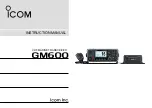Si4010-C2
30
Rev. 1.0
Table 10.4. Si4010 RF Transmitter Characteristics
(TA = 25° C, VDD = 3.3 V, RL = 480
,, SOIC package unless otherwise noted)
Parameter
Symbol
Test Condition
Min
Typ
Max
Unit
Frequency Range
1
F
RF
27
—
960
MHz
Frequency Noise (rms)
2
Allen deviation, measured
across 1 ms interval
—
0.3
—
ppm
Phase Noise @ 915 MHz
10 kHz offset
—
–70
—
dBc/Hz
100 kHz offset
—
–100
—
dBc/Hz
1 MHz offset
—
–105
—
dBc/Hz
Frequency Tuning Time
—
5
—
ms
Carrier Frequency
Accuracy
0 °C
≤
T
A
≤
70° C
–150
—
+150
ppm
–40 °C
≤
T
A
≤
85° C
–250
—
+250
ppm
Frequency Error
Contribution with
External Crystal
–10
—
+10
ppm
Transmit Power
3
Maximum programmed TX
power, with optimum differen-
tial load, V
DD
> 2.2 V
—
10
—
dBm
Minimum programmed TX
power, with optimum differen-
tial load,
V
DD
> 2.2 V
—
–13
—
dBm
Power variation vs temp and
supply, with optimum
differential load, V
DD
> 2.2 V
–1.0
—
0.5
dB
Power variation vs temp and
supply, with optimum
differential load, V
DD
> 1.8 V
–2.5
—
0.5
dB
Transmit power step size
from –13 to 10 dBm
—
0.25
—
dB
PA Edge Ramp Rate
Programmable Range
OOK mode
0.34
—
10.7
us
Data Rate
OOK, Manchester encoding
0.1
—
50
kBaud
FSK, NRZ encoding
0.1
—
100
kBaud
Notes:
1.
The frequency range is continuous over the specified range.
2.
The frequency step size is limited by the frequency noise.
3.
Optimum differential load is equal to 3.5 V/(11.5 mA/2 x 4/PI) = 480
Therefore the antenna load resistance
in parallel with the Si4010 differential output resistance should equal 480
4.
Total NVM copy time = 2 ms + (NVM copy Boot Time per kB) x (NVM data in kB).


















